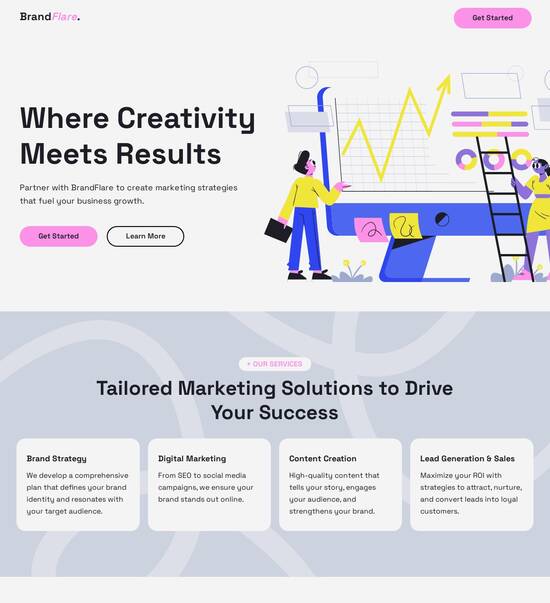
HTML page template for Project managers
Use TemplateAbout template
Attract clients and showcase your skills with style using our landing page templates for Project managers. Let's convert those visitors into clients!
Recommended templates

Easy to build without coding
With the intuitive drag-and-drop builder, anyone on your team can create high-converting pages without any knowledge of code or design. Make enhancements to your landing page with custom widgets using Javascript, HTML/CSS, or third-party scripts.

Multiple layouts for any industry and goal
Select from 500+ landing page layouts built to boost conversions across industry-specific scenarios. Customize them by adjusting fonts, adding images, and generating on-brand content with the AI assistant. Quickly scale with Instablocks® and Global Blocks that you can save, reuse, and update globally.

Loads fast and looks polished on any device
Every template is responsive, which means they present professionally on any device and load blazingly fast with our Thor Render Engine. You can also power them up with Google AMP technology to deliver an unparalleled mobile experience and drive higher conversions.

Robust analytics & experimentation
Get real-time updates and reporting across all your devices, showing the number of visitors, conversions, cost-per-visitor, and cost-per-lead. Launch AI-powered experiments, run A/B tests, and use heatmaps to analyze user behavior, then optimize your landing page to maximize conversions.







Easy to build without coding
With the intuitive drag-and-drop builder, anyone on your team can create high-converting pages without any knowledge of code or design. Make enhancements to your landing page with custom widgets using Javascript, HTML/CSS, or third-party scripts.
Multiple layouts for any industry and goal
Select from 500+ landing page layouts built to boost conversions across industry-specific scenarios. Customize them by adjusting fonts, adding images, and generating on-brand content with the AI assistant. Quickly scale with Instablocks® and Global Blocks that you can save, reuse, and update globally.
Loads fast and looks polished on any device
Every template is responsive, which means they present professionally on any device and load blazingly fast with our Thor Render Engine.
Robust analytics & experimentation
Get real-time updates and reporting across all your devices, showing the number of visitors, conversions, cost-per-visitor, and cost-per-lead. Launch AI-powered experiments, run A/B tests, and use heatmaps to analyze user behavior, then optimize your landing page to maximize conversions.
All the features you need to build lead-generating landing pages
Explore more featuresLearn how to build top-performing landing pages for any goal
FAQs
Leading the way in building high-performing landing pages





An all-in-one landing page solution for marketers
Using Instapage, marketers can leverage a powerful landing page and conversion rate optimization platform designed to transform digital campaigns efficiently. This guide outlines the steps to create landing pages that not only engage leads but also significantly increase return on investment (ROI). With ready-to-use templates and intuitive features, you can elevate your campaigns regardless of your team size or budget.
Understanding the fundamentals of landing page creation
Creating an effective landing page involves several key elements that attract and retain visitors. Marketers in sectors such as business services and tech/SaaS can benefit strongly from a well-optimized approach. Here are the essential components to keep in mind:
- High-quality visuals: Utilize images and videos that resonate with your target audience to enhance engagement.
- Compelling headlines: Create attention-grabbing headlines that communicate value quickly.
- Call-to-action buttons: Design clear and persuasive CTAs that guide users towards the desired action.
Steps to create a high-converting landing page
Follow these steps to set up a landing page that drives results effectively. You can utilize Instapage's over 100 conversion-centered templates, ensuring your page is both appealing and functional.
- Select a template: Choose a template that aligns with your campaign goals. Instapage provides customization tools to adapt it to your brand identity.
- Incorporate lead generation elements: Add forms and opt-in features that are strategically placed to enhance conversion.
- Utilize built-in optimization tools: Analyze heatmaps and user behavior to tweak your page for better performance.
Testing and optimization strategies
To maximize the effectiveness of your landing page, regular testing and optimization are crucial. Utilize the following strategies:
- A/B testing: Experiment with different headlines, images, and CTAs to identify what drives higher conversions.
- Analytics dashboard: Monitor performance metrics to gain insights into user behavior and preferences.
- Continuous improvements: Use gathered data to make informed updates, ensuring your landing page remains relevant and effective.
In conclusion, mastering the art of landing page creation with Instapage empowers marketers to build high-converting pages seamlessly. Take advantage of its robust features to test and refine your strategies effectively.
Ready to supercharge your marketing campaigns? Sign up for Instapage and start optimizing your landing pages today!
People also ask about HTML page template for Project managers
HTML page template for project managers
Understanding the importance of HTML page templates in project management
HTML page templates are pre-designed web pages built using HyperText Markup Language (HTML) that serve as a framework for various online projects. By using these templates, project managers can ensure that the visual and functional elements of their digital resources are consistent and effective. They offer a structured way to communicate information, maintain branding, and engage with stakeholders.
For project managers, HTML page templates are crucial in streamlining digital workflows. Streamlined processes not only save time but also enhance productivity. Project managers can focus more on managing tasks and less on repeating design work. In this fast-paced environment, efficiency is vital for meeting deadlines and achieving project objectives.
Additionally, understanding the difference between static and dynamic HTML templates is essential. Static HTML templates are fixed and display the same content regardless of user interaction, making them suitable for simple, unchanging information. Conversely, dynamic HTML templates can adapt based on user input or data changes, allowing for more interactive experiences that can cater to different audience needs.
Key features of HTML page templates for project managers
When considering HTML page templates, key features can significantly enhance project management tasks. A user-friendly design is foundational; intuitive layouts create an engaging user experience that enhances navigability, making it easier for teams to collaborate. Customizability is also essential, allowing project managers to tailor elements to fit their branding and project requirements, ensuring that all communications align with the organization’s goals.
User-friendly design and structure: Intuitive layout that enhances navigability and user experience.
Customizability options for branding: Tailorable designs that reflect the project’s unique identity.
Pre-designed elements tailored for project-related needs: Includes task lists, project milestones, and feedback sections.
In terms of integration, many HTML page templates are compatible with popular project management tools. This allows for seamless embedding of tools like Gantt charts, Kanban boards, and timelines, which visually represent project progress and facilitate better team collaboration. Furthermore, the templates often include data handling and management capabilities. Secure forms for collecting user data help maintain privacy while allowing project managers to capture critical information like usernames and emails, crucial for managing communication.
Benefits of using HTML templates in project management
Using HTML templates in project management offers substantial benefits, especially in enhancing collaboration among team members. A shared platform for project updates serves as a central hub for all communications, allowing teams to provide real-time feedback and updates. These interactive aspects are essential for ensuring continuity and clarity throughout project lifecycles.
Enhanced collaboration among team members: Shared platforms encourage immediate input and a collective focus.
Lead generation and contact management: Templates can facilitate stakeholder information collection using user-friendly forms.
Improved data visualization and reporting: Integrated metrics, dashboards, and charts help track progress and demonstrate results.
Lead generation becomes more streamlined with registration forms embedded in HTML templates, allowing project managers to collect essential stakeholder information efficiently. Coupled with ongoing communication, this structured approach to data management can significantly enhance relationship-building efforts. Furthermore, HTML templates often incorporate impressive data visualization tools that display metrics clearly, enabling managers to track milestones and share critical insights with stakeholders.
Practical applications for project managers
The practical applications of HTML page templates for project managers are diverse and impactful. Creating project-specific landing pages allows managers to present project objectives, updates, and relevant information in a visually appealing manner. This not only informs team members but also engages stakeholders actively throughout the project.
Creating project-specific landing pages: Custom pages can showcase project goals and updates effectively.
Setting up user registration and access control: Allow for secure account creation and management.
Implementing effective communication strategies: Use contact forms and newsletters to maintain stakeholder engagement.
Moreover, HTML templates facilitate strategies for user registration and access control. Detailed plans can include account creation processes that capture essential user info, ensuring tailored access levels based on project roles. This structured approach enhances data security while simplifying user management, allowing project managers to focus on key project deliverables.
Exploring innovative aspects of HTML page templates
As technology evolves, the role of automation in utilizing HTML templates has become increasingly significant. Automation enables project managers to streamline routine processes such as data handling and email notifications. By setting automated triggers, project updates can be generated and sent out without manual input, freeing up valuable time.
The role of automation in template utilization: Automatic data handling saves time and reduces errors.
Mobile responsiveness and accessibility: Ensures templates function smoothly on various devices for all users.
Importance of accessibility features: Catering to diverse teams enhances collaboration.
Furthermore, ensuring templates are mobile-responsive and accessible is critical in today’s diverse work environment. Mobile-friendly designs ensure that project updates and information are available to team members regardless of their location or device. Accessibility features should also be integrated to support every team member and facilitate effective collaboration.
Privacy and data security in HTML template usage
Incorporating privacy and data security measures is paramount when utilizing HTML templates. Understanding privacy policy implications is crucial, especially when collecting and managing user data. By including clear links to privacy policies within templates, project managers inform users about data handling practices, reinforcing trust and transparency.
Best practices for including privacy policy links: Transparency about data handling reinforces user trust.
Ensuring secure data handling: Implementing encryption techniques protects sensitive information.
Regular audits for compliance: Helps maintain adherence to data protection regulations.
Ensuring secure data handling extends to adopting encryption techniques that protect user data collected through forms. It is also vital to conduct regular audits to maintain compliance with relevant regulations, an essential practice for safeguarding sensitive information and building rapport with users.
Measuring success with HTML page template integration
Establishing key performance indicators (KPIs) is an effective way to measure the success of HTML page template integration in project management. Examples of relevant KPIs include user engagement rates, form completion rates, and feedback submission statistics. Tracking these metrics can provide valuable insights into user interaction and template efficacy.
Setting up key performance indicators (KPIs): Measure user engagement and project success.
Gathering feedback for continuous improvement: Evaluate user experiences to refine templates.
Analyzing user experience: Understanding usability helps enhance design.
Collecting feedback through clearly defined mechanisms also plays a critical role in refining HTML templates. By continuously evaluating user experience and iterating on designs, project managers can ensure that the templates fulfill their intended purpose and improve over time.
Case studies: Success stories of HTML template usage in project management
Case studies provide valuable insights into the successful deployment of HTML templates within project management. For instance, organizations that effectively leveraged HTML templates saw significant improvements in team collaboration, information dissemination, and stakeholder engagement. By examining specific tools and methodologies, these success stories highlight practical applications and lessons learned.
Highlighting organizations that successfully leveraged HTML templates: Real-world applications demonstrate effectiveness.
Discussing specific tools and methodologies: Sharing techniques that contribute to project successes.
Lessons learned and best practices: Deriving insights to inform future projects.
These case studies not only showcase effective practices but also contribute to developing best practices for future projects, ensuring that project managers can utilize HTML templates to their fullest potential.
The future of HTML templates in project management
Looking ahead, the future of HTML templates in project management appears promising, especially with ongoing technological advancements. Innovations in HTML design will continue to evolve, offering project managers even more tools for efficiency and effectiveness. As organizations increasingly adopt digital tools, project managers' roles in leveraging these technologies will continue to expand.
Predictions on technological advancements: Continued evolution of design and integration capabilities.
The evolving role of project managers: Adoption of digital tools enhances workflow management.
Upcoming trends that shape HTML templates: Integration of AI and enhanced data handling features.
Furthermore, trends such as enhanced data handling and artificial intelligence in template design could transform how project managers integrate HTML templates into their workflow, fostering even more opportunities for innovative project management practices.
Ready to skyrocket conversions?
Supercharge your ad campaigns with high-performing landing pages
Get started














